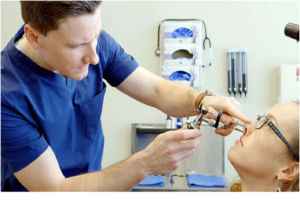
Ortho-K lenses (short for orthokeratology) are gas-permeable lenses used to reshape the cornea. The patient typically wears the lenses overnight. When they remove them in the morning, they will have good vision for the rest of the day without needing glasses or daytime contact lenses. Ortho-K lenses help treat many vision problems, including astigmatism, myopia, and hyperopia. Here are seven facts concerning corneal reshaping and Ortho-K lenses that you may not have known.
1. Ortho-K Lenses are not a recent invention.
Ortho-K lenses are sometimes referred to as a new breakthrough, yet they were first utilised in the 1940s when surgeons found that glass contact lenses could reshape the cornea.
Development continued for several decades, with the method finally gaining traction in the 1990s. From advances in gas-permeable lenses to computerised corneal topography software, technology has advanced significantly over the years.
We now know that orthokeratology is one of the most efficient methods of reducing myopia progression in youngsters.
2. The effects might linger for many days.
Although patients should wear their contact lenses every night for optimum outcomes, the effects typically last longer than one day. In fact, after wearing Ortho-K lenses for one night, it is normal for patients to have their vision corrected for up to two full days. You may wear the lenses throughout the day, but they are more pleasant at night since they reshape the cornea. Therefore, it’s usually more vital to wear the lenses every night at first when the reshaping process is taking place. Then, you can wear them more frequently as your therapy develops.
3. It’s not painful.
Corneal reshaping may appear painful, but it is not. This is because the reshaping is not the consequence of squeezing or “squishing.” Instead, it is caused by hydraulic forces. The lens produces a vault of fluid over the eye, causing some portions of the cornea to absorb more liquid than others, altering the shape of the cornea and temporarily correcting curvature concerns.
4. It is especially advantageous for youngsters.
Ortho-K lenses can help practically everyone, but youngsters are especially ideal candidates. This is because LASIK surgery is not appropriate for these young people. On the other hand, children who do not wish to wear glasses typically obtain excellent outcomes with Ortho-K lenses. We now know that this therapy is one of the most effective ways of decreasing progressive myopia in children and is quickly becoming the gold standard for myopia control. Other suitable candidates include people with a particular prescription range and those who require vision correction without using corrective glasses, such as pilots, police officers, or sports.
5. Fittings need more than one visit.
It may take several visits to the eye doctor to properly fit Ortho-K lenses. Fittings typically take several weeks and entail numerous sets of temporary lenses to obtain the correct fit. This procedure assures a good fit and good outcomes.
6. Ortho-K is not covered by insurance.
Most vision insurance companies do not cover Ortho-K lenses since they are deemed elective. Most people, however, believe that the expense of this treatment is well worth the benefits. Imagine having good vision all day without glasses or contact lenses, and it’s simple to see why so many people prefer Ortho-K lenses despite the out-of-pocket price.








